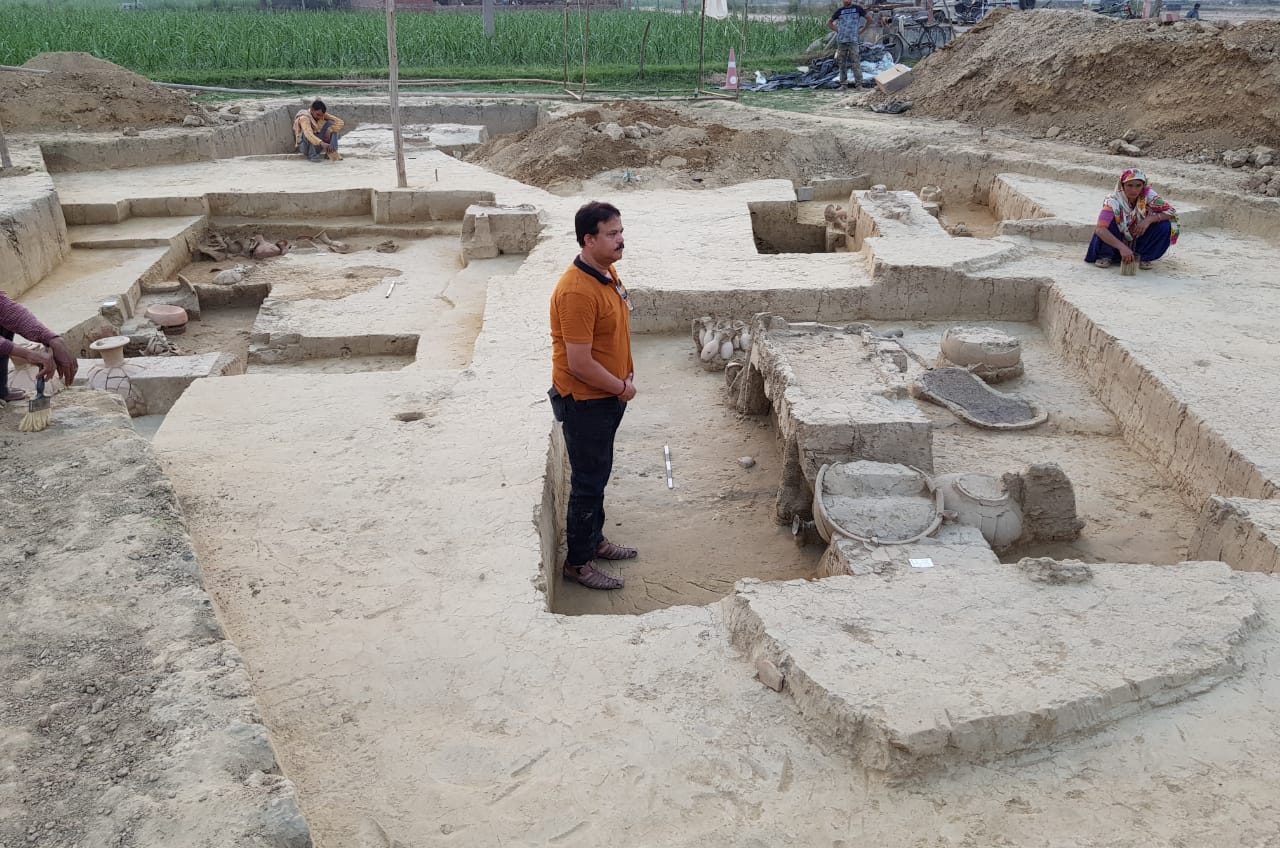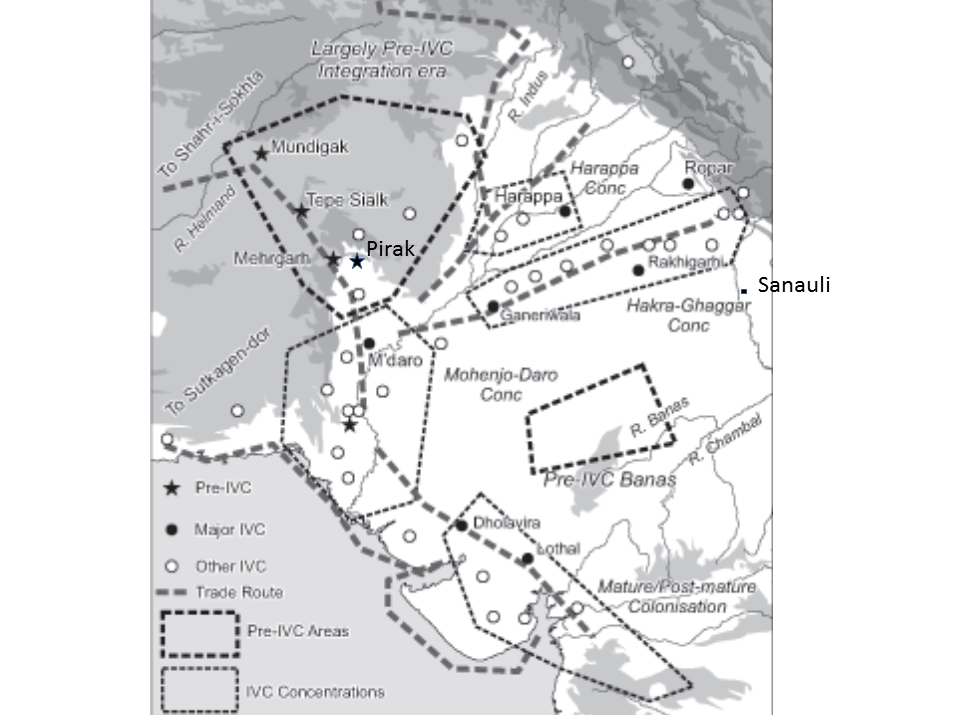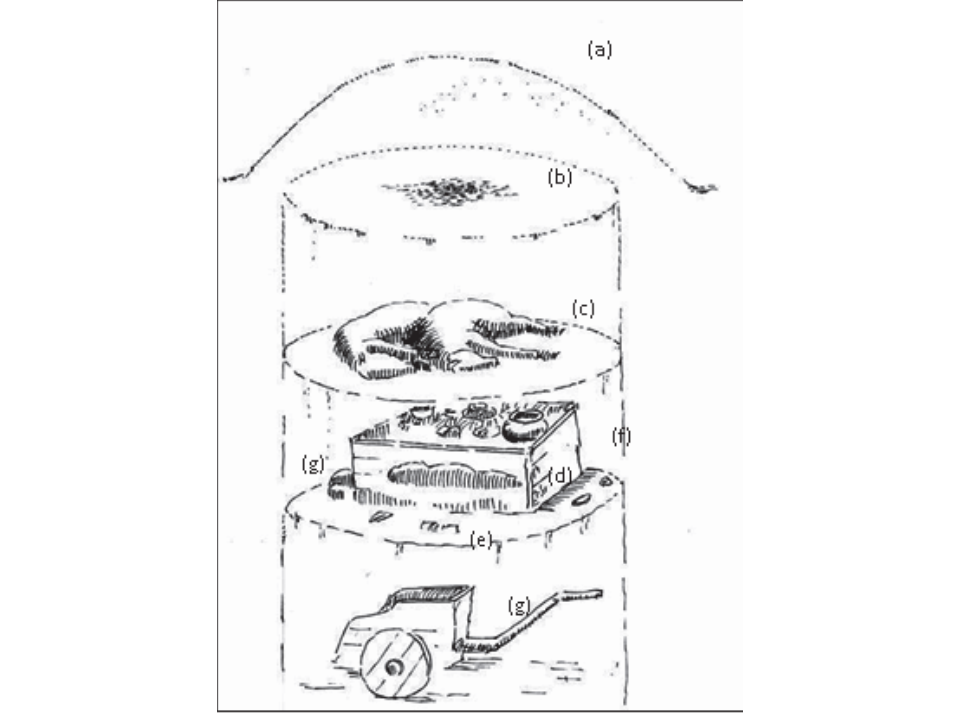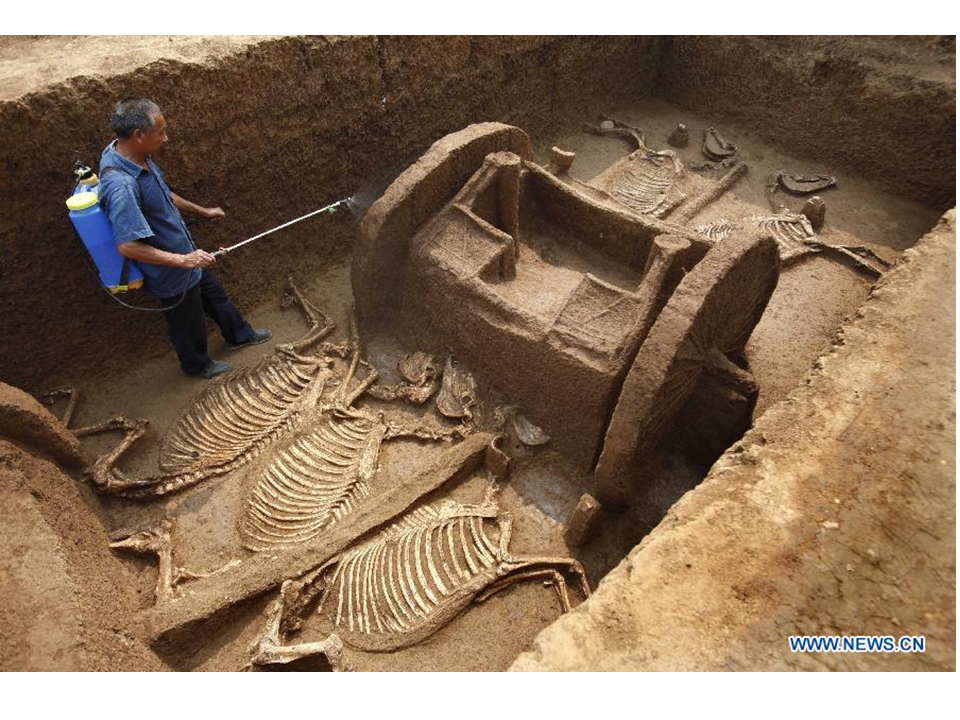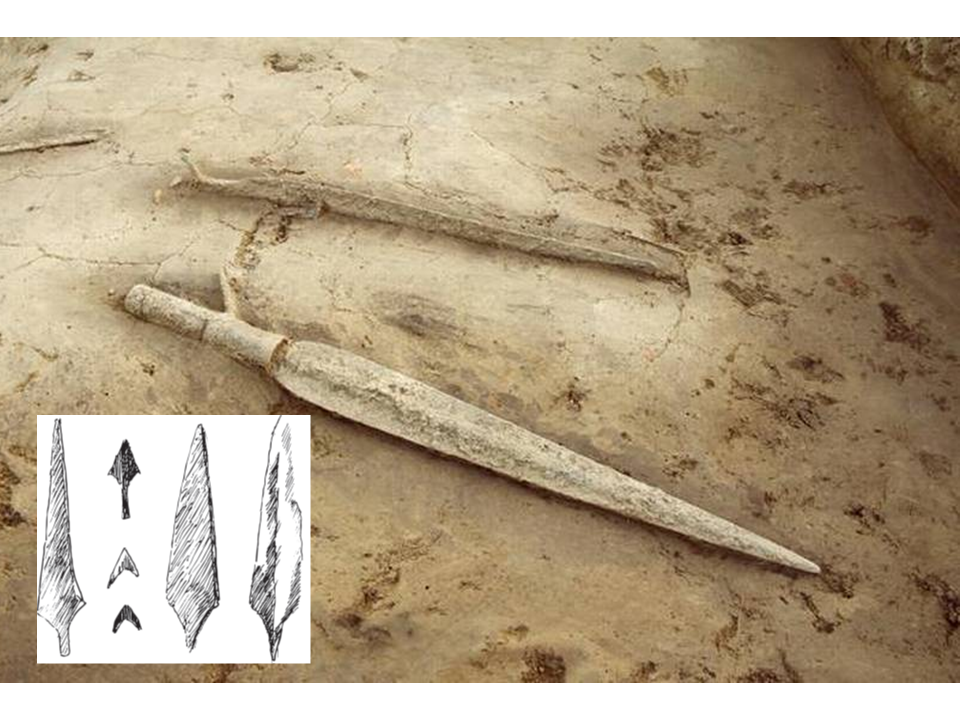A good read ..
‘Chariots’ at Sanauli: their Impact on the Story of Early South Asia
Saikat Bose Military History,
Uncategorized May 9, 2019 18 Minutes
A recent archaeological discovery to elicit great interest is that of the ‘royal’ burials at Sanauli, a site in the Baghpat District on the Yamuna 80 km north of Delhi. The most spectacular finds here are three ‘war-chariots’, the first of its kind in India, which have added a new facet to the ongoing debate on the formation of early South Asian society.
The team of archaeologists on the site, which has estimated the finds to be from 3800–4000 years before present (no technical dating has yet been carried out), has pronounced them
war-chariots. By extension, this is being taken as conclusive proof of the existence of horses in India and their not having been introduced from Central Asia
c. 1500 BC, which has remained a major point of contention in the Indo–Aryan debate. The increasingly confident right, one of whose sociological objectives centres on revisionism, has already begun celebrating the finds as the near-final nail in the coffin of the Aryan-invasion theory.
Further, Sanauli being in the heartland of the terrain traditionally associated with the
Mahabharata (as per local tradition, Baghpat is one of the ‘five villages’ demanded by the Pandavas of the Kauravas in settlement), allied quarters have started claiming that the chariots represent the contestant groups in the epic.
True Indology, a popular Right-Wing Twitter handle (apparently suspended at present), has stated that the discovery “
fundamentally changes long held perceptions about ancient India”, and insists that “…
mainstream historians long held that chariots were introduced into India from Central Asia [whereas] … (t)
he chariot has been excavated from Sanauli which is in heartland of Kurukshetra.”
These viewpoints must not be laughed away, but admitted only if scientifically upheld by data and not socio-political enthusiasm. Either way, Sanauli is as likely to upset several long-held perceptions as it is to reinforce them. This photo-essay seeks to place Sanauli in the context of the ongoing debate, and provide a caveat that, rather than excitement about favourite socio-political persuasions being allowed to hijack the issue, it is rational analyses of the finds that must decide their significances.
Map showing Sanauli, and Other Important Sites and Cultures referred to in the Essay
The Excavations
Sanauli had been excavated once in 2003–06, when a necropolis with 116 bodies had been discovered along with Red Ware ranging from elegant dish-on-stand to simple
lota.
[1]
These finds were associated with the Late Harappan period; the site seems to have been an extension of Late Harappan culture on to the Yamuna–Ganga interfluve. Current excavations commenced in 2018 when a local gentleman warned the ASI of some finds, and are being conducted by the Institute of Archaeology, the academic wing of ASI, under its Director Sanjay Manjul, and his wife Arvin Manjul, Superintending Archaeologist, Excavation Branch-II.
Among the exciting finds in the new dig, only 100 m from the necropolis, are three elite burials with wooden coffins, two of which have revealed a total of three vehicle-like contraptions that are being supposed to be chariots. Also, secondary burials (interment of human remains that were first exposed), symbolic burials (interment of artefacts, probably used by the deceased or representing the deceased), bones of ceremonially sacrificed animal, and other goods like copper helmets, swords with tang and hilt, scabbards, flared and lidded pottery, metal mirrors, comb and jewellery, have been found. Two of the coffins are sheathed in copper, but the third, that of an exceptionally tall woman, was not; the wood of the coffins have rotted away, but copper sheaths, including inlaid anthropomorphic figurines, have survived.
The wooden bodies of the ‘chariots’ have also perished, fusing with the earth. However, small copper triangles that covered the body have survived, sticking
in situ to the earth. The wheels are solid, i.e. without spokes, and are decorated with similar copper triangles arranged in three concentric rings. The vehicles had a chassis of hollow copper tubes, including an upright probably for attaching a standard or canopy, and semi-circular seats. It has been stated that one of the chariots has a pole and yoke, decorated likewise with copper triangles, though no images are publicly available.
Prima Facie Appearances
As the digs are far from complete, and the recovered material not yet subjected to technical analysis, coming to conclusions at this stage is premature. Thus, some of the on-site team’s estimates may be a little to soon. Despite advocating caution, in interviews and interactions with visitors Dr. Manjul has remarked that “…
chariots … raths (he used the Indian term for a chariot) …
were previously found only in Greece and Mesopotamia.”
[2] Elsewhere, he has stated that the discovery (Sanauli) puts India at par with ancient civilizations in Mesopotamia and Greece, and that “…
when the Mesopotamians were using chariots, swords and helmets in war, a warrior tribe here was using them as well”. He has also stated that “
conclusive evidence of horses, including fossils of teeth, have been found at other Harappan sites”, and that such horses may not have come from Central Asia but from the Tibet highlands across the Himalayas.
This set of statements takes for granted that the Sanauli vehicles were
horse-drawn war-chariots. However, there is no direct evidence of horses, like skeletons, bones or clay figurines, unlike similar burials in China and the Urals where entire horses were found interred with chariots. Below is a schematic sketch of the structure of a
kurgan grave, found in South Russia:
Grassy mound (a), marks of a ritual fire (b), sacrificed horses (c), chamber with wooden sarcophagus (d), the corpse (e) assorted grave goods (f) other people sacrificed with the main intern (g), proto-chariots[3]
Nor is there any indirect evidence, like snaffle-bits, rein-holders, or metal rivets of halters. Of the copper tubes forming the chassis, one front-facing tube-end in the lower front of one vehicle is being taken as the socket for the pole, and a straight pole is being stated to have been discovered. At one place Manjul has even provided an illustration of the yoking arrangement with a straight pole and a cross beam. Inserting a pole into the socket at the front end of a chariot would make for a weak arrangement, for unless the draft pole ran to the end of the chariot, with the axle lashed crosswise to it, the tractive effort of the animals would not be transmitted to the wheels, and the chariot front would tend to tear away. Also, the straight pole and short, crosswise yoke in Manjul’s sketch are better suited to humped cattle and not the horse; the straight pole would either lie to close to the legs of the horse, interfering with their gait. If raised, it would cause the chariot floor to tilt backwards. The ideal chariot pole is curved upwards, as seen in this reconstructed chariot found at a
kurgan grave in Arkaim.
And finally, the solid wheels would never do for a true war-chariot, which required lighter and springier spoked wheels to make them manoeuvrable.
In other words, as per the definition of war-chariot being a
horse-drawn vehicle that was used for military purposes, the Sanauli vehicle’s position seems to be ambiguous. It may not have been drawn by a horse after all, but perhaps by bulls, oxen or asses, and it is even more unlikely to have been put to military use. It will do well to remember that the chariot spoken of in the Vedas, the
vipatha, is a light construction, with spoked wheels in a bent felloe, and not one with a solid wheel like the one at Sanauli. This is similar to the chariots also used in the Mahabharata. The Sanauli chariot would have been too heavy and rigid to be used for the type of aggressive and evasive driving required by war-chariots.
Having encountered the
prima facie negative evidence of the horse, and before considering the weaponry discovered at the site, the essay will turn its attention to tracing the archaeological picture of the region in general.
Tracing the Archaeological Narrative
The Indo–Gangetic plains and upper Deccan had been under dispersed occupation since Palaeolithic times. At around 3000 BC, Palaeolithic and Neolithic sites across the region are found supplanted by discrete metal-using cultures (mostly using copper with low bronze components) concentrated on the Indus and the Ghaggar, with outposts in the South and East. This was the
regionalization era of the Indus Valley, also called Early Harappan, and lasted up to 2600 BC. 2600 BC onwards, the diverse sites appear to have been assimilated into a remarkably homogenous culture spreading across 2000 sites in modern-day India and Pakistan. Known as Mature Harappan, this culture is seen to have expanded wider than the regions occupied by the Early Harappn, with outposts in what today are Northern Pakistan and Afghanistan and the upper Deccan. However, there is no evidence that the homogenising influence had been militarily enforced, or even by one physical type. Nor is there any evidence of a ruling class, format of governance, or of a ‘capital’.
[4] Possibly it was an intensely mercantile world ‘ruled’ by custom, with each town ruled by a council of ‘priests’.
The Mature Harappan is seen to have lasted up to
c. 1900 BC, after which its homogenising influence loosened. There is no evidence of civilizational collapse or depopulation of the countryside, as trade with Mesopotamia continued (Harappans, known as
Meluhhans, continued to appear in Mesopotamian references till 1500 BC), while, as Possehl has shown, Harappan motifs like the bullock cart, mathematics, or
kullaḍh clay cups survived in the countryside.
[5] This Late Harappan period lasted till
c. 1500 BC, after which many sites are abandoned. Also, a significant shift of populations towards the east is observed, while references in Mesopotamian records cease.
Concurrently, discrete cultures are seen to be appearing across the Indo–Gangetic plains. Some of these were pre-existing cultures that had now shaken off the homogenising influence, while some are new. This
localisation era of the IVC survived the petering out of Late Harappan, till they themselves appear to have been subsumed by other archaeologically discernible cultures like the
Cemetery H or
Painted Grey Ware. It will do well here to seek the mechanics of the transformation and survey the affiliations of some of these cultures.
Absence of evidence of any military graduation of the Indus Valley from a
regionalisation era to Mature Harappan has been noted. Similarly, there is scant evidence to indicate military reasons for transition of Mature Harappa into Late Harappan, i.e. its
localisation era. Two sets of evidence do appear towards the end of the Late Harappa. The first set comprises some hesitant signs of military emergency discernible in the last layers of Late Harappa (what is called the Jhukar phase at some sites)—diluting civic standards, squatter tenements and even kilns inside town limits, and military engineering like strengthening and heightening of walls and addition of keeps and gates. A few towns in the Western fringes of the IVC appear to have been destroyed militarily (though this is not conclusive evidence that other towns had not been taken militarily, for their forces may well have been defeated in open battle).
The second set of evidence come from Pirak, Nausharo, Sibri, Mundigak, or Mehrgarh South Cemetery, along the western uplands of the Indus valley (see map above), where new sites coeval with Late Harappan begin to appear. These sites are very different from Harappan, and show affinity with Iranic cultures of the Bactria–Margiana Archaeological Complex (BMAC),
[6] and steppe cultures further north. For instance, Pirak has yielded terracotta figurines of mounted horsemen, the oldest equestrian figures from anywhere in South Asia,
[7] while Mundigak and Shahi-Tump have yielded bronze straight-swords and well-crafted axes with shaft-holes.
[8]
Some of the advanced weapons at post-mature layers of the IVC. The adze-axe at Mohenjo-Daro is about 9” long and resembles weapons found at Shahi-Tump near the Afghan–Iranian border. Its socket to receive the shaft demonstrates an advanced casting technology. The bronze straight-sword at the bottom is more than 16” long, has a sturdy midrib and a comfortable pommel. Such swords have been found from a vast area extending from Rajanpur in Punjab in the east, to Luristan in Iran in the west, as also in the Caucasus
Taken together, the two sets of evidences give hesitant indications of disruptions beyond the western passes caused by warlike peoples, which possibly triggered an influx of refugees that caused a decline in civic standards and ultimate abandonment of some of the Indus Valley towns. Unlike the end of Mature Harappa from when there is no evidence of military catastrophe, there is some evidence of military struggle in some parts of the IVC at the very end of the Later Harappa phase. However, on the whole the IVC was spared the devastation like that visited on contemporaneous cultures in Mesopotamia and Asia Minor. Later, the diverse cultures of Late Harappa and the
localisation era are found to have been subsumed into other assimilative phases, like
Cemetery H centred on Harappa and Bahawalpur.
[9] Period 4 on Mounds E and AB at Harappa marks the transition from Harappan to Cemetery H, after which Harappa is abandoned.
[10] It is important to correctly place Sanauli in the archaeological narrative traced above.
Competing Cultures of the Later and Post-Harappan Era
Of the many cultures of the
localisation era, two of the more interesting and significant ones in this narrative are the
Gomal grave culture in the Pothwar plateau (South of Taxila), and the
Gandhara grave cultures extending into the Swat valley North of Taxila. Both places have evinced interesting burial practices.
Gomal graves are circular pits layered with wood, with clay figurines of women, bulls and horses and personal effects of the deceased, all sealed with a layer of clay and burnt.
[11]The
Gandhara graves are more elaborate and also contain sacrificed animals and large clay urns in the shape of stylised human faces.
[12] The latter has yielded riding equipment, including horse-bits, cheek-pieces, and bronze sceptres with horse-capitals, with affinity with artefacts found at the Sintashta–Arkaim sites in the Urals. The Pakistani archaeologist Dani has associated these sites with Indo–Aryans and traced these funerary practices as a continuum through the BMAC to the steppes.
Though neither
Gandhara nor
Gomal graves contained horse or chariots, they do give indication of the association of the horse with mortuary practices. The upper layers in the sites of both these cultures are found to have been subsumed into the
Cemetery H culture, but their archaic elements are discerned in sites in the upper reaches of the Swat valley. It appears that earlier occupants of these sites had withdrawn into the mountains with the arrival of later populations, who were subsequently assimilated into the
Cemetery H culture. Many burials in the mountains of Swat indicate association with the horse, like Katelai (two horses buried with their masters), Timurgarha (iron cheek-pieces and rivets of a bridle, similar in design with Ukrainian and Romanian finds) or Loebanhr (articles like pins, brooches, or handles of face–urns lids, all shaped like horses).
[13]
Also, found dotted across Swat, as across Eurasia, are petroglyphs (rock paintings) of horse-drawn vehicles. These petroglyphs are in rocky heights, where no chariot could have reached. It has been postulated that these are indications of sky burials.
[14] Funerary associations of the horse and chariot appear elsewhere, as in the funerary races held in many warrior societies (like the one held after the death of Patrocles in the
Iliad). Certain passages in the Ṛg Veda
[15] underline the funerary associations of the chariot.
[16] As mentioned and depicted above,
kurgan burials appear in the Eurasian steppes, like the ones at the type-sites in Sintashta or Arkaim in Chelyabinsk province in the South Russian Urals. Tumuli containing chariots have been discovered in sites associated with the early Romans and the Celts in Western Europe also. Elaborate, multi-decked chariot burials have been discovered in northern China; a recent burial has been discovered while constructing a parking lot in Louyang city in China.
The remains of five wooden chariots and 12 horses sacrificed to pull them in the afterlife have been discovered in Louyang city, China. These are akin to many such chariot burials from earlier periods.
Many Indo–European mythological systems mention
houses or
chambers in the context of graves, like the
House of Hades or
Hall of Heljarann. The Vedas mention the
House of Yama.
[17] However, It is significant that several animals, mostly the dog, have been found in such graves across Eurasia; dogs are the gatekeepers and guides to the underworld in most I–E mythology. However, nowhere are such burials associated with any equine (asses, onagers) other than the horse; in most burials, horses are found to have been sacrificed and laid out neatly next to the poles. Though this is not the case at Sanauli, it is still reasonable to assume that the vehicles here were drawn by the horse, and thus, can be called chariots. At the same time, considering the suboptimal and possibly frail structure (solid wheels and indifferent yoking arrangement) of the Sanauli chariot, it is unlikely that they actually were
war-chariots.
This also brings us to the evidence of weapons found in the graves.
A well-crafted weapon, probably of copper though it may be of bronze, found in one of the graves [inset, visible less effective weapons associated with the Harappan culture].
The graves have yielded blades and copper sheaths, probably scabbards, some of which are depicted above. Insofar as the blades have midribs, they are strong. However, though not yet put through metallurgical analysis to determine their tin or arsenic content, the blades seem to be of copper from the amount of Verdigris on the surface, and not bronze. The blades resemble weaponry found in the many dumps of copper implements, the so-called
Copper Hoards, like in the existence of barbs. One blade seems to have had a wooden handled (the wood has rotted away) secured with copper strap. The blades found in the woman’s grave are flimsier, and it is being interpreted as showing her lesser affluence (as neither was her coffin sheathed in copper). This may not be the case, as neither are the other weapons, though more advanced than Harappan weapons, are battle-worthy (as seen in the inset above). Arvin Manjul is probably right in postulating that these were ceremonially used.
In the chalcolithic age or in that of bronze, light swords that could keep their keenness were difficult to construct and maintain, and consequently knobkerries, maces and heavy swords were of greater military utility. In contemporary Sumeria, crew of four-wheeled, ***-drawn battle wagons used hooked scimitars, but these were not war-chariots and their doctrine of employment was entirely different. The weapon that made true war-chariots was a bow small enough to be used on board a chariot (though not yet as small in span as bows that would in time be used by mounted archers). Relics of such bows have been found in most chariot-graves where the graves are associated with military elites. At places where they were not, like at Sintashta, the chariot was not a war-chariot.
[18] This is true of the Sanauli chariot as well, where no relic or other evidence of archery (metal or bone arrowheads, bone or horn ends (ears) of bows, or metal quivers) has been found.
The Way Ahead
The above discussion helps us come to the conclusion that the paraphernalia of chariot and weaponry discovered at Sanauli were ceremonial, for funerary purposes only. Thus, it is premature on the part of Dr Manjul to proclaim the existence of a warrior class similar to that of West Asia. Also, though lying in terrain associated with the epic, the overwhelmingly copper–bronze context of the finds and complete absence of relics of archery equipment imply that the graves are from a period earlier than the Mahabharata era. It must be remembered that the Mahabharata era was the cusp of the Bronze (or what passed for it in South Asia where there was no classical Bronze Age) and the Iron Ages, i.e.
c. 1000 BC, when iron weapons were hesitatingly appearing, with archery a major component of weaponry.
As a working hypothesis, it can be assumed that the culture of the Sanauli chariots was one of the discrete cultures of the
localisation era, formed by one of the several incoming groups coeval with Late Harappa. In this period, the chariot was still a ceremonial vehicle with major funerary associations (as vehicle for the soul’s journey in the after-world, like the boat to the Vikings). I have outlined elsewhere the militarisation of the chariot in mid-2nd millennium BC which precipitated a completely upset steppe society, probably caused by improved yoking arrangements and import of the idea of the smaller bow from West Asia.
[19] This militarisation is possibly reflected in South Asia by the subsuming of these discrete cultures into the
Cemetery H, and in scriptural matter by the so-called
Battle of the Ten Kings.
Thus, the Sanauli finds, far from being the ‘final nail in the coffin of the Aryan Invasion Theory’, actually seems to reinforce it. Only that there was not one ‘invasion’, but gradual immigration of a series of tribes and groups, which showed as much belligerence towards one another as against autochthonous groups, and were increasingly militarised towards the end. Manjul’s contention, that horses have been found at Harappan sites, is incorrect—the only equine relic found at any of the Harappan layers comes from Surkotada, which was probably that of a large ***. However, his statement that the horse was probably imported across the Himalayas from Tibet and used in South Asia does have merit, for this may have been
also a source of horses, in addition to horses that were always imported down the Khyber, Gomal and the Bolan.
As said above, it is essential to exploit the opportunity provided by the Sanauli finds to increase our understanding of the period, and not allow them to be subverted by socio-political agendas. In this regard, it is brought out with alarm that in 2015, David Frawley a frequent collaborator of N.S. Rajaram, the American researcher of Indian origin whose 1999 hoax of digitally modifying Harappan seals to prove that the Harappan civilisation was Vedic was exposed, was awarded the
Padma Bhushan by the government.
It will also be unfortunate if certain gentlemen, poster-boys of revivalist revisionism, appropriate the finds into the politically preferred story of the Seven Rivers (
While making estimates are in order, it is incorrect to come to premature conclusions and generate factoids. Rather, in addition to discovering and carefully docketing all artefacts, actions that must be carried out by agencies executing the excavation are outlined in the following paragraphs.
The finds must be subjected to technical and metallurgical analyses at the earliest to accurate date them and also understanding their physical and chemical contents. This also includes subjecting the skeletons to DNA analysis. While this already would have been planned, it is essential to do these at the earliest before the artefacts are contaminated by handling.
This is the first opportunity to study a chariot, at least a proto-chariot, in the South Asian context, and the construction and structure of the vehicle must be mapped using physical reconstruction and 3D modelling. This will help understand the physical characteristics and operating efficiency of the chariot, including speed, manoeuvrability and robustness.
The physical construction of the grave or hall where the chariot was found—whether it was hollow or packed, tightly or loosely, with earth or some other material, and whether it had a roof—must be mapped so as to understand the funerary procedures of this group.
Interim reports on the excavations must be published progressively, with one published at the earliest, making public the discoveries made so far. This will enable concurrent analyses to commence. Such a study must be not independent, but attempt to put into perspective all the several sites discovered in the recent past.
{This essay uses images which are already on the open domain and thus accessible)
[1]T.S. Subramanian, ‘Royal burial in Sanauli’, Frontline, 28 September 2018, available at
https://frontline.thehindu.com/arts-and-culture/heritage/article24923229.ece
[2]See for example Baishali Adak, ‘ASI studies ‘Mahabharata-era’ Sanauli relics at Red Fort, tests to unravel more secrets’, 30 July 2018, available at
https://www.indiatoday.in/mail-toda...uld-belong-to-2000-1800-bc-1299851-2018-07-30
[3]Adapted from the specific reconstruction of a burial from the Great Kurgan at Sintashta by Gening; see V.F. Gening, G.B. Zdanovich, and V. V. Gening, Sintashta: Arkheologicheskie pamyatniki arijskikh plemen Uralo-Kazakhstanskikh stepej (in Russian), vol. 1: Chelyabinsk: Yuzhno-Ural’skoe knizhnoe izdatel’stvo, 1992, Fig. 54, represented in Parpola, ‘The Nāsatyas, the Chariot and Proto–Aryan Religion’,
Journal of Indological Studies, nos. 16 & 17, 2004–2005, pp. 1–63.
[4] Some self-proclaimed experts have selected Rakhigarhi for reasons best known to them, and only unconvincingly articulated.
[5]G.L. Possehl, ‘The End of a State and the Continuity of a Tradition’, in R. Fox (ed.),
Realm and Region in Traditional India, Delhi, Vikas, 1979, pp. 234–54.
[6]F.T. Hiebert and C.C. Lamberg–Karlovsky, ‘Central Asia and the Indo-Iranian Borderlands’,
Iran, vol. 30, 1992, pp. 1–15.
[7]Asko Parpola, ‘The Coming of the Aryans to Iran and India and the Cultural and Ethnic Identity of the Dasas’,
International Journal of Dravidian Linguistics, vol. 17, no. 2, June 1988, pp. 85–229 (especially pp. 150–151).
[8]S. Piggott,
Prehistoric India to 1000 B.C., Harmondsworth, Penguin, 1950, pp. 220.
[9]M. R. Mughal, ‘New archaeological evidence from Bahawalpur’, in A. H. Dani (ed.),
Indus Civilization: New Perspective, Islamabad, Centre for the Study of the Civilizations of Central Asia, Quaid-e Azam University, 1981, pp. 33–41 (especially p. 37).
[10]Mukhtar Ahmed,
Ancient Pakistan: An Archaeological History, vol. 3: Harappan Civilization—the Material Culture, Reidsville, Foursome Group, 2014, p. 452.
[11]A.H. Dani, ‘Pastoral–Agricultural Tribes of Pakistan in the Post-Indus Period’, in A.H. Dani and V.M. Masson (eds.)
History of Civilizations of Central Asia, vol. 1, Paris, UNESCO, 1992, pp. 395–420.
[12]Dani, ‘Pastoral–Agricultural’, p. 404.
[13]Asko Parpola, ‘Face Urns of Gandhara and the Nasatya Cult’, in Michael Willis (ed.),
Migration, Trade and Peoples, Proceedings of the Eighteenth Congress of the European Association of South Asian Archaeologists, London, 2005, the British Association for South Asian Studies, London, British Academy, 2009, pp. 149–162, Fig. 1.
[14]Esther Jacobsen–Tepfer, ‘The Image of Wheeled Vehicle in the Mongolian Altai: Instability and Ambiguity’,
The Silk Road, vol. 10, 2012, pp. 1–28.
[15]ṚV, X: 135; see also
ṚV, VI: 28, ‘O Divine chariot etc …’ which also appears in
AV, VI: 125.1–3.
[16] See Saikat K. Bose,
Framing the Mahabharata, against the Evolution of Early South Asian Society, Delhi, Vij, 2018, pp. 91–94 for a discussion on the subject.
[17]Actual house structures have been found at the Únetice burials at Leubingen in Saxony; see Marija Gimbutas,
Bronze Age cultures in Central and Eastern Europe, The Hague/London, Mouton,1965, pp. 260–265, figs. 172 and 173.
[18] M.A. Littauer and J. Crouwel, ‘Origin of the True Chariot’, in M.A. Littauer and J. Crouwel,
Antiquity, no. 70, 1996, pp. 934–939 (see p. 936).
[19] Bose,
Framing the Mahabharata, pp.100–105
